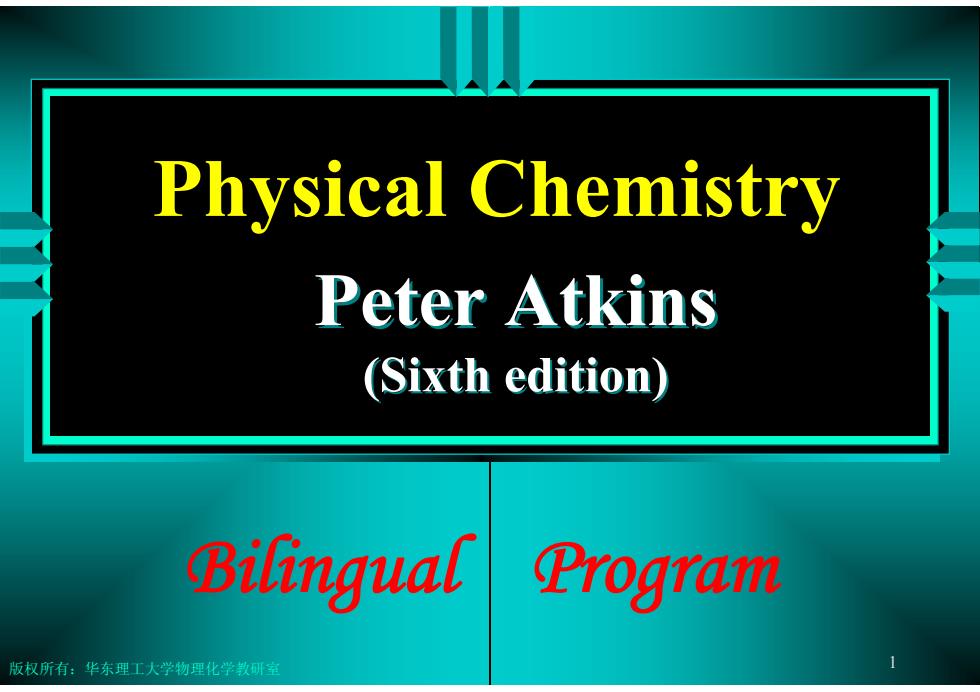
版权所有:华东理工大学物理化学教研室 1 Physical Chemistry Peter Atkins Peter Atkins (Sixth edition) (Sixth edition) Bilingual Program
版权所有:华东理工大学物理化学教研室 1 Physical Chemistry Peter Atkins Peter Atkins (Sixth edition) (Sixth edition) Bilingual Program

版权所有:华东理工大学物理化学教研室 2 Part 1: Equilibrium Part 3: Change Part 2: Statistics
版权所有:华东理工大学物理化学教研室 2 Part 1: Equilibrium Part 3: Change Part 2: Statistics
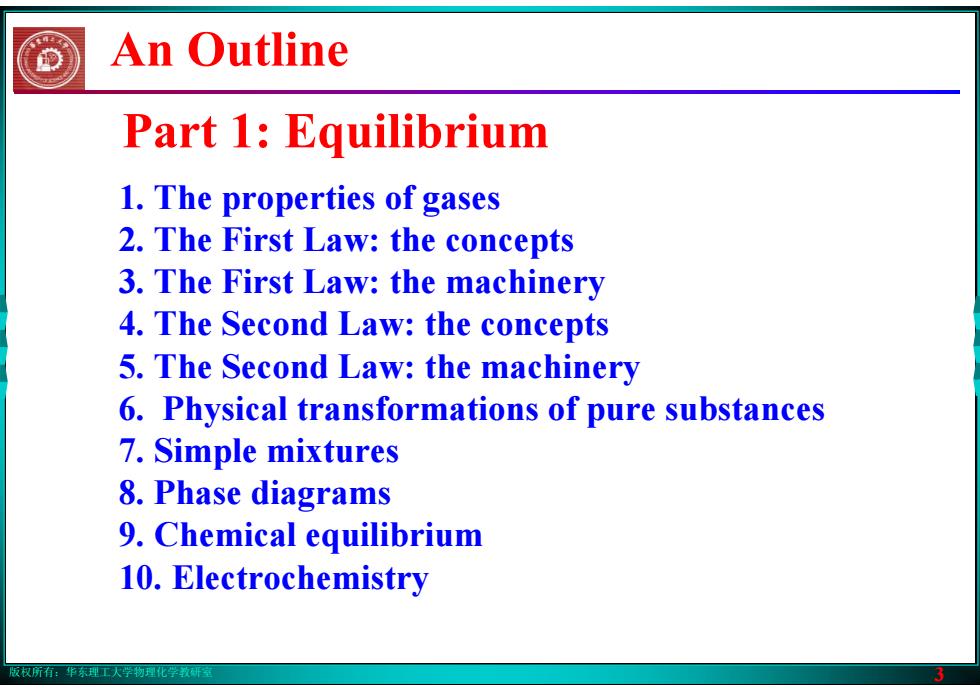
版权所有:华东理工大学物理化学教研室 3 1. The properties of gases 2. The First Law: the concepts 3. The First Law: the machinery 4. The Second Law: the concepts 5. The Second Law: the machinery 6. Physical transformations of pure substances 7. Simple mixtures 8. Phase diagrams 9. Chemical equilibrium 10. Electrochemistry An Outline Part 1: Equilibrium
版权所有:华东理工大学物理化学教研室 3 1. The properties of gases 2. The First Law: the concepts 3. The First Law: the machinery 4. The Second Law: the concepts 5. The Second Law: the machinery 6. Physical transformations of pure substances 7. Simple mixtures 8. Phase diagrams 9. Chemical equilibrium 10. Electrochemistry An Outline Part 1: Equilibrium

版权所有:华东理工大学物理化学教研室 4 Part 1: Equilibrium Part 3: Change Part 2: Statistics An Outline
版权所有:华东理工大学物理化学教研室 4 Part 1: Equilibrium Part 3: Change Part 2: Statistics An Outline
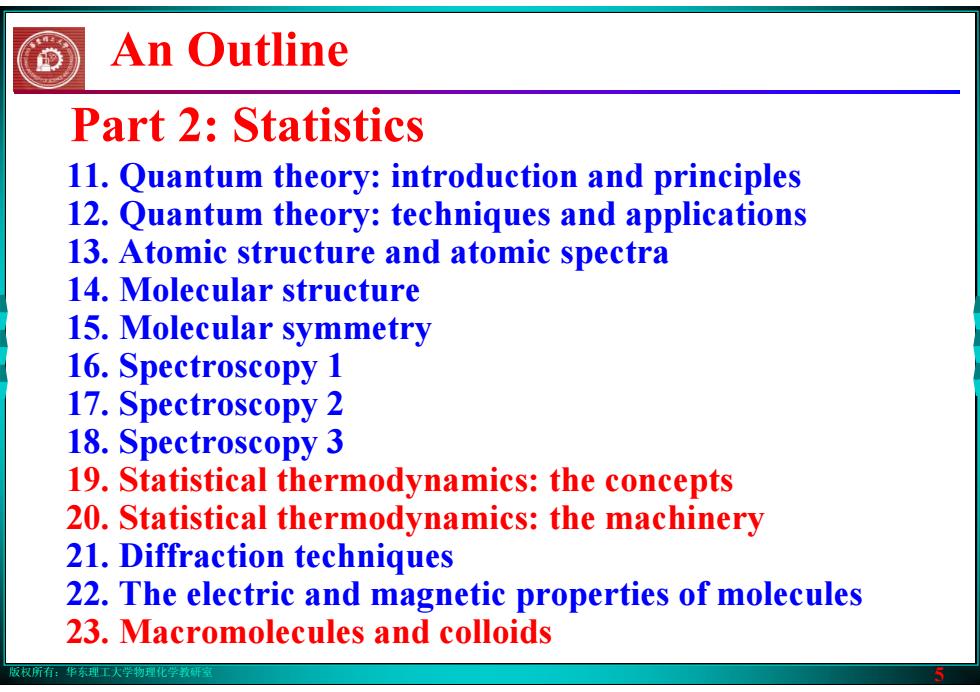
版权所有:华东理工大学物理化学教研室 5 Part 2: Statistics 11. Quantum theory: introduction and principles 12. Quantum theory: techniques and applications 13. Atomic structure and atomic spectra 14. Molecular structure 15. Molecular symmetry 16. Spectroscopy 1 17. Spectroscopy 2 18. Spectroscopy 3 19. Statistical thermodynamics: the concepts 20. Statistical thermodynamics: the machinery 21. Diffraction techniques 22. The electric and magnetic properties of molecules 23. Macromolecules and colloids An Outline
版权所有:华东理工大学物理化学教研室 5 Part 2: Statistics 11. Quantum theory: introduction and principles 12. Quantum theory: techniques and applications 13. Atomic structure and atomic spectra 14. Molecular structure 15. Molecular symmetry 16. Spectroscopy 1 17. Spectroscopy 2 18. Spectroscopy 3 19. Statistical thermodynamics: the concepts 20. Statistical thermodynamics: the machinery 21. Diffraction techniques 22. The electric and magnetic properties of molecules 23. Macromolecules and colloids An Outline
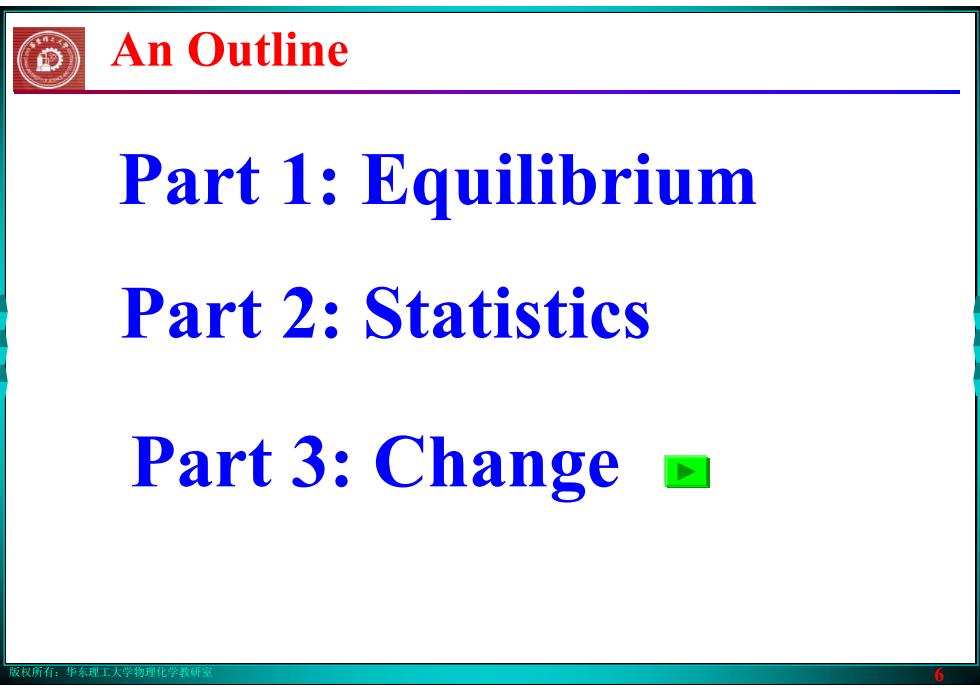
版权所有:华东理工大学物理化学教研室 6 Part 1: Equilibrium Part 3: Change Part 2: Statistics An Outline
版权所有:华东理工大学物理化学教研室 6 Part 1: Equilibrium Part 3: Change Part 2: Statistics An Outline
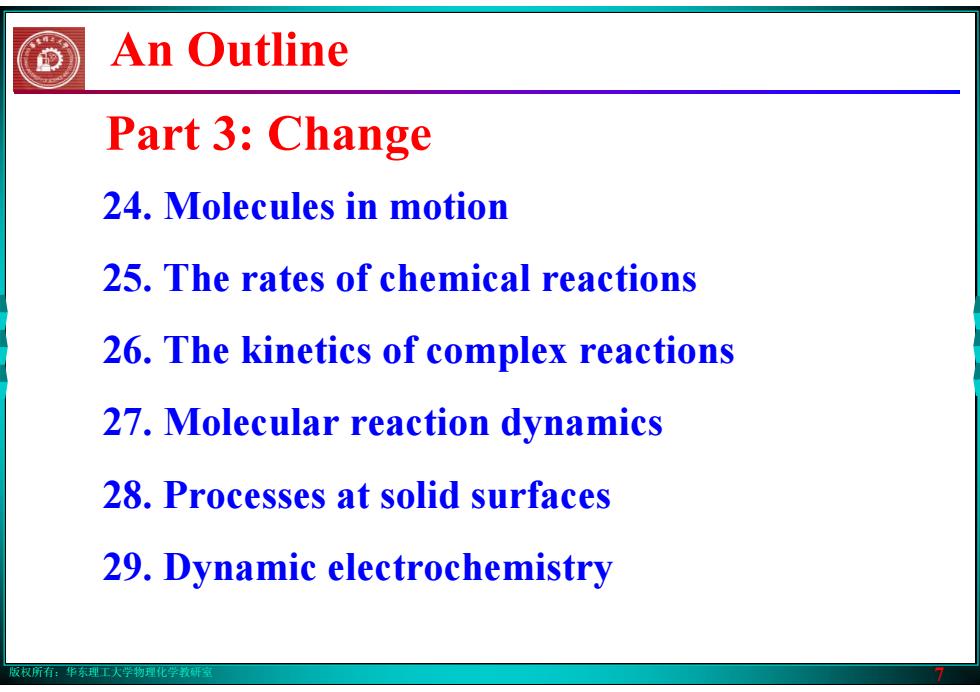
版权所有:华东理工大学物理化学教研室 7 24. Molecules in motion 25. The rates of chemical reactions 26. The kinetics of complex reactions 27. Molecular reaction dynamics 28. Processes at solid surfaces 29. Dynamic electrochemistry Part 3: Change An Outline
版权所有:华东理工大学物理化学教研室 7 24. Molecules in motion 25. The rates of chemical reactions 26. The kinetics of complex reactions 27. Molecular reaction dynamics 28. Processes at solid surfaces 29. Dynamic electrochemistry Part 3: Change An Outline

版权所有:华东理工大学物理化学教研室 8 Following each chapter, there are Exercise and Problem sections. An Exercise is a straightforward, direct application of an item in the text. A problem is more c o m p l e x a n d m a y d r a w o n t h e l i t e r a t u r e . The further problems are summarized in Micro-Projects in the end of each Part. These Micro-Projccts are designed to draw on knowledge from all the chapters in each part. The MicroProjccts are intended to be helpful when reviewing the material of each part of the text, and a l s o p r o v i d e s o m e interesting applications. An Outline
版权所有:华东理工大学物理化学教研室 8 Following each chapter, there are Exercise and Problem sections. An Exercise is a straightforward, direct application of an item in the text. A problem is more c o m p l e x a n d m a y d r a w o n t h e l i t e r a t u r e . The further problems are summarized in Micro-Projects in the end of each Part. These Micro-Projccts are designed to draw on knowledge from all the chapters in each part. The MicroProjccts are intended to be helpful when reviewing the material of each part of the text, and a l s o p r o v i d e s o m e interesting applications. An Outline

9 版权所有:华东理工大学物理化学教研室 上一页 下一页 返回目录 Part 1: Equilibrium Bilingual Program 0. Introduction
9 版权所有:华东理工大学物理化学教研室 上一页 下一页 返回目录 Part 1: Equilibrium Bilingual Program 0. Introduction
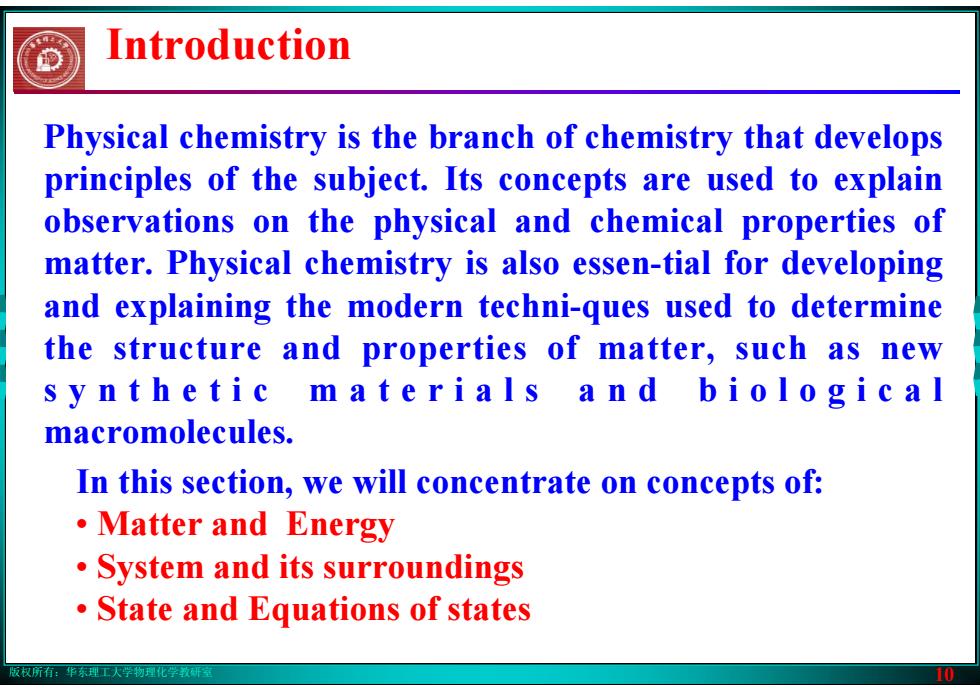
版权所有:华东理工大学物理化学教研室 10 Introduction Physical chemistry is the branch of chemistry that develops principles of the subject. Its concepts are used to explain observations on the physical and chemical properties of matter. Physical chemistry is also essen-tial for developing and explaining the modern techni-ques used to determine the structure and properties of matter, such as new s y n t h e t i c m a t e r i a l s a n d b i o l o g i c a l macromolecules. In this section, we will concentrate on concepts of: • Matter and Energy • System and its surroundings • State and Equations of states
版权所有:华东理工大学物理化学教研室 10 Introduction Physical chemistry is the branch of chemistry that develops principles of the subject. Its concepts are used to explain observations on the physical and chemical properties of matter. Physical chemistry is also essen-tial for developing and explaining the modern techni-ques used to determine the structure and properties of matter, such as new s y n t h e t i c m a t e r i a l s a n d b i o l o g i c a l macromolecules. In this section, we will concentrate on concepts of: • Matter and Energy • System and its surroundings • State and Equations of states